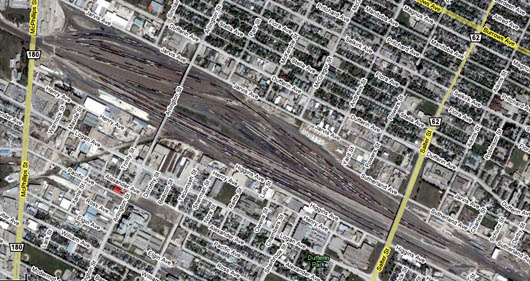
16 January 2008
Few on Board for Big Move

Canadian Pacific Railway yard Winnipeg
Manitoba.
Winnipeg Manitoba - It's a dream of many a Canadian city.
Ridding the downtown of noisy, dirty, troublesome, railway lines and yards, opening up valuable new real estate for development and, in
the process, transforming a decaying core into a vibrant, beating heart once again.
Alas, this is one of those dreams that for the most part, remains unfulfilled. The rail lines continue to run through the middle of
most major Canadian cities and the opportunities for redevelopment remain beyond reach.
In Windsor, local government and provincial officials are struggling to get co-operation from CN to have it abandon a
90-kilometre stretch of freight line between Windsor and Chatham so that it can be used as a freeway.
In Moncton, the city government is rushing to find a plan to rid its downtown of rail lines, urged on by the knowledge that
freight-container traffic originating in the port is expected to triple in the coming years.
In Winnipeg, NDP MP Pat Martin tackled the issue this week by floating the latest iteration of a plan to relocate the Canadian Pacific
Railway yards in the near North End of the city. The yards are, as they have always been, a deep and ugly gash through the very heart
of the city. Relocating the rail lines and yards is, theoretically, one of those win-win situations, Martin
offered: Safer, cleaner and, ultimately, more efficient for the railways.
And yet, there is absolutely no interest, it appears, in looking at the idea. CP told the Free Press rather tersely that it wasn't
considering a move. Finance Minister Greg Selinger, who studied this issue for his doctorate at the London School of Economics,
declined to comment. City officials, including Mayor Sam Katz, are intrigued but non-committal.
Martin's renewed interest in the North End yards was also a reminder of the failure of government and the railways to relocate the Fort
Rouge Yards, which occupy key land immediately south of downtown. That land was supposed to be a catalyst for a new era of
inner-city development, and a prime opportunity for rapid transit to move people in and out of the core. It has been a
colossal failure as well.
It hasn't always been so. Decades ago, some of Canada's most successful cities succeeded in relocating rail lines and that forward
thinking is still paying dividends.
Ottawa did it in the 1950s and the legacy of that visionary planning can be seen in the national capital's abundance of greenspace.
Calgary undertook the relocation of some rail lines in the 1960s, a plan that, in part, helped create the world-class
river parkway it enjoys today.
Regina is perhaps the only city today that is making headway in disentangling the railways from its core. In December, the three levels
of government and CP announced plans for a four-year, $93-million project that will relocate the railway's
main intermodal terminal to land west of the city's airport, taking rail traffic out of the downtown and freeing up 20 acres of prime
downtown real estate.
Regina had initially proposed a complete relocation of all rail lines in the downtown, but could not find either the will or the money
to make that happen.
And therein lies the great dilemma with this issue: Although few dispute the benefits of relocating railway assets, few seem to
be able to justify the enormous cost.
Dr. Barry Prentice, a University of Manitoba transportation expert, said there are many reasons why CP might want to move. There are
cost savings in moving the rail yards west of the city to land it already owns near the Winnipeg airport as its current facilities are
not particularly efficient. But the railways tend to focus most of their capital spending on expanding track capacity and alleviating
bottlenecks; moving facilities just doesn't make for a compelling business case.
The same holds true for government, which ultimately pays the majority of costs associated with railway relocation. Federal legislation
allows Ottawa to force relocation at the request of local and provincial governments, but only if they are willing to pay moving and
operational costs above and beyond what the railways can recover in cost-efficiencies.
Prentice noted there are opportunities for government to recoup its investment, primarily from the economic activity and taxes
generated by redevelopment. But whether these gains offset the enormous cost is anyone's guess, he added. The risk continues to
outweigh the reward, it appears.
Relocating rail yards and lines is an enormous challenge with enormous potential benefits. Unfortunately, we are not living in an era
of bold public policy and visionary planning.
Dreams are hard to realize when we are surrounded by leaders who do not dare to dream.
|